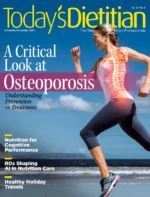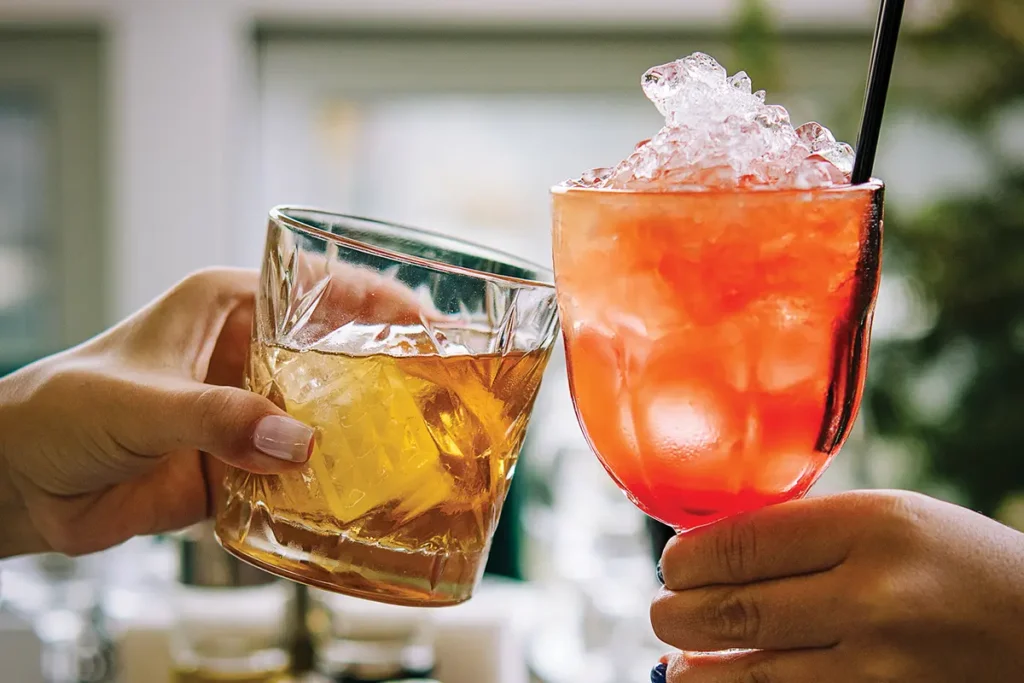Today’s Dietitian
Vol. 27 No. 5 P. 12
It should come as no surprise that alcohol consumption can be detrimental to athletic performance. High calorie counts, dehydration, liver function changes, and altered nutrient absorption are just some of the side effects of alcohol consumption that dietitians are aware of.1 When it comes to high-performance athletes, the addition of high training volume, hectic schedules, poor hydration practices, and other types of elevated stress can further exacerbate these issues, and mount additional concerns.
The performance impacts of even limited amounts of alcohol can impair immune health, muscle protein synthesis, recovery, and endurance in individuals who train frequently and for long periods of time.2,3 “Drinking alcohol can have several effects on athletic performance and recovery. Consuming the amount of alcohol in less than one beer may lead to a reduction in aerobic performance,” says Marie Spano, MS, RD, CSCS, CSSD, sports dietitian for the Washington Nationals. “In addition, regular posttraining intake of larger amounts of alcohol (0.5 g of alcohol per kg bodyweight; a little less than four beers for a 200 lb person) could reduce muscular adaptations.”
It’s well-documented that ethical issues prohibit extensive human trials on alcohol and athletic performance,2 but there’s extensive survey data on collegiate athletes that dietitians can use to educate themselves and the athletes they care for.
Athlete Stats
According to data published by the National Collegiate Athletic Association (NCAA), more than 70% of college athletes report drinking alcohol, with more than one-half reporting experiencing a hangover in the last year. Alcohol consumption rates are similar across divisions I, II, and III, with some increased prevalence seen in both males and females at the Division III level.4
Across divisions, more than one-third of female athletes report drinking more than four drinks when they do consume alcohol. While 10% to 15% of male athletes report drinking more than 10 drinks in an outing.
As for those hangovers effects—the physiological effects of alcohol consumption, including increases in heart rate and blood pressure, as well as compromised nutrient absorption, decreased endurance performance, and compromised muscle recovery, can last for days after an event of drinking.
Lesser-Known Effects on Performance
From injury risk to mental health afflictions, the impact of alcohol on performance is further reaching than health care providers may realize. Here are six examples from the available research and clinical expertise.
Increased Risk of Injury
Regular consumption of alcohol has been found to increase risk of injury both on and off the playing field. Data suggests that weekly alcohol consumption doubles the rate of injury.4
More Than a Headache
In the aftermath of a night of drinking, athletes may believe that the impact of alcohol only lasts as long as the initial hangover symptoms are evident. According to data published by Firth and Manzo, one night of drinking five or more drinks can affect brain and body activities for up to three days. Consecutive nights of drinking compound these lingering effects.5
Multifaceted Sleep Disruption
“It takes very little alcohol to affect sleep, recovery, and performance” shares Chris Mohr, PhD, RD, and co-owner of Mohr Results, Inc. “Alcohol may help you fall asleep, but that isn’t the same deep, quality sleep that is truly needed to recover, repair, and prepare for the next day(s). Alcohol has been shown to disrupt restorative sleep cycles throughout the night, decreasing quality of sleep.”6 As Mohr further demonstrates, sleep impacts are linked to not only the sedative effect of alcohol but also the late nights that often accompany social drinking. “To compound this, when athletes enjoy a night out drinking, they may stay out later than normal, reducing their sleep duration. These two factors together yield an even greater disruption of energy production, recovery, and performance,” Mohr adds.
Binge Drinking
Binge drinking is defined as four or more drinks for women or five or more drinks for men in one sitting. These benchmarks, coupled with self-reported drinking frequency, indicate that many college athletes regularly participate in binge drinking. On a positive note, a newly published survey of NCAA athletes revealed a 20% decrease in binge drinking episodes since 2009.7
ABV Matters
All alcoholic beverages disclose the percent alcohol by volume (%ABV). The more potent the alcoholic content the greater the impact on dehydration. “While every drink, except alcohol, contributes to hydration, drinks containing 4% or greater alcohol content (4% is about the amount in a light beer) will delay rehydration and cause a net fluid loss,” Spano says.
Mental Health
Many athletes already struggle with mental health issues, including anxiety, depression, and sleep disorders, and the depressant effect of alcohol can further disrupt the balance of neurotransmitters involved in these conditions. Adolescents are even more susceptible to the negative mental health ramifications of alcohol, and these issues can continue into adulthood.8
Guidance for Clinicians
While abstinence from alcohol may be the best option for athletes from a performance standpoint, it’s not always a realistic expectation. There are some guidelines dietitians can suggest to athletes who don’t want to avoid alcohol completely.
Low- or No-Alcohol Options
Cutting back on alcohol has become trendy. Initiatives like “Dry January” and other sober-curious movements have changed how many people think about social drinking. Restaurants and bar menus are offering more mocktails, and the selections for nonalcoholic spirits and beers have drastically increased. The celebratory ritual of drinking may be most appealing to some athletes. “Choose nonalcoholic options that are available, to still “feel” like you’re enjoying celebrating, but without alcohol,” Mohr suggests.
Consider Timing
Just like most things in sports nutrition, considering if and when to drink alcohol should come down to timing. “It’s best if athletes cut down on their alcohol intake. If they don’t want to cut it out completely, they may want to consider drinking at times when they aren’t close to competition or right after competition,” Spano says. Athletes are encouraged to make in-season accommodations because of the demands of their schedule. “So, for instance, a team sport athlete who plays every Saturday and Wednesday may want to consider Thursday their night to enjoy a drink or two.”
Mohr echoes this sentiment. “If you have to train or compete the following day, a night out wouldn’t be a wise idea, whereas you can maybe save that if you have a day or two off, and you would be better to choose to drink then.”
Education on Portions of Alcohol
Athletes may miscalculate just how many “drinks” are in their drink order. Mixed drinks, martinis, and craft beers often equate to multiple servings of alcohol per glass or can, and will easily add up to major performance deficits. Proper education on servings of alcohol can help athletes make better decisions about the quantity of alcohol they choose to consume and hopefully lead to a corresponding decrease in detrimental impacts.
— Dana Angelo White, MS, RDN, ATC, is a dual registered dietitian nutritionist and certified athletic trainer with over 20 years of clinical experience. She is a media dietitian, cookbook author, and full-time professor and sports RDN at Quinnipiac University in Hamden, Connecticut.
References
1. Shield KD, Parry C, Rehm J. Chronic diseases and conditions related to alcohol use. Alcohol Res. 2013;35(2):155-73.
2. Shirreffs SM, Maughan RJ. The effect of alcohol on athletic performance. Cur Sports Med Rep. 2006;5(4):192-196.
3. Levitt DE, Luk HY, Vingren JL. Alcohol, resistance exercise, and mTOR pathway signaling: an evidence-based narrative review. Biomolecules. 2022;13(1):2.
4. NCAA student-athlete substance use study. National Collegiate Athletic Association website. https://www.ncaa.org/sports/2013/11/20/ncaa-student-athlete-substance-use-study.aspx. Accessed February 20, 2025.
5. Firth G, Manzo LG. For the athlete: alcohol and athletic performance. https://stepupprogram.org/docs/handouts/FortheAthlete_AlcoholandAthleticPerformance.pdf. Published 2004.
6. Ebrahim IO, Shapiro CM, Williams AJ, Fenwick PB. Alcohol and sleep I: effects on normal sleep. Alcohol Clin Exp Res. 2013;37(4):539-549.
7. Johnson G. Student-athletes report drop in binge drinking, use of narcotic pain medication and spit tobacco. National Collegiate Athletic Association website. https://www.ncaa.org/news/2024/1/9/media-center-student-athletes-report-drop-in-binge-drinking-use-of-narcotic-pain-medication-and-spit-tobacco.aspx. Published January 9, 2024. Accessed February 21, 2025.
8. Lees B, Meredith LR, Kirkland AE, Bryant BE, Squeglia LM. Effect of alcohol use on the adolescent brain and behavior. Pharmacol Biochem Behav. 2020;192:172906.



